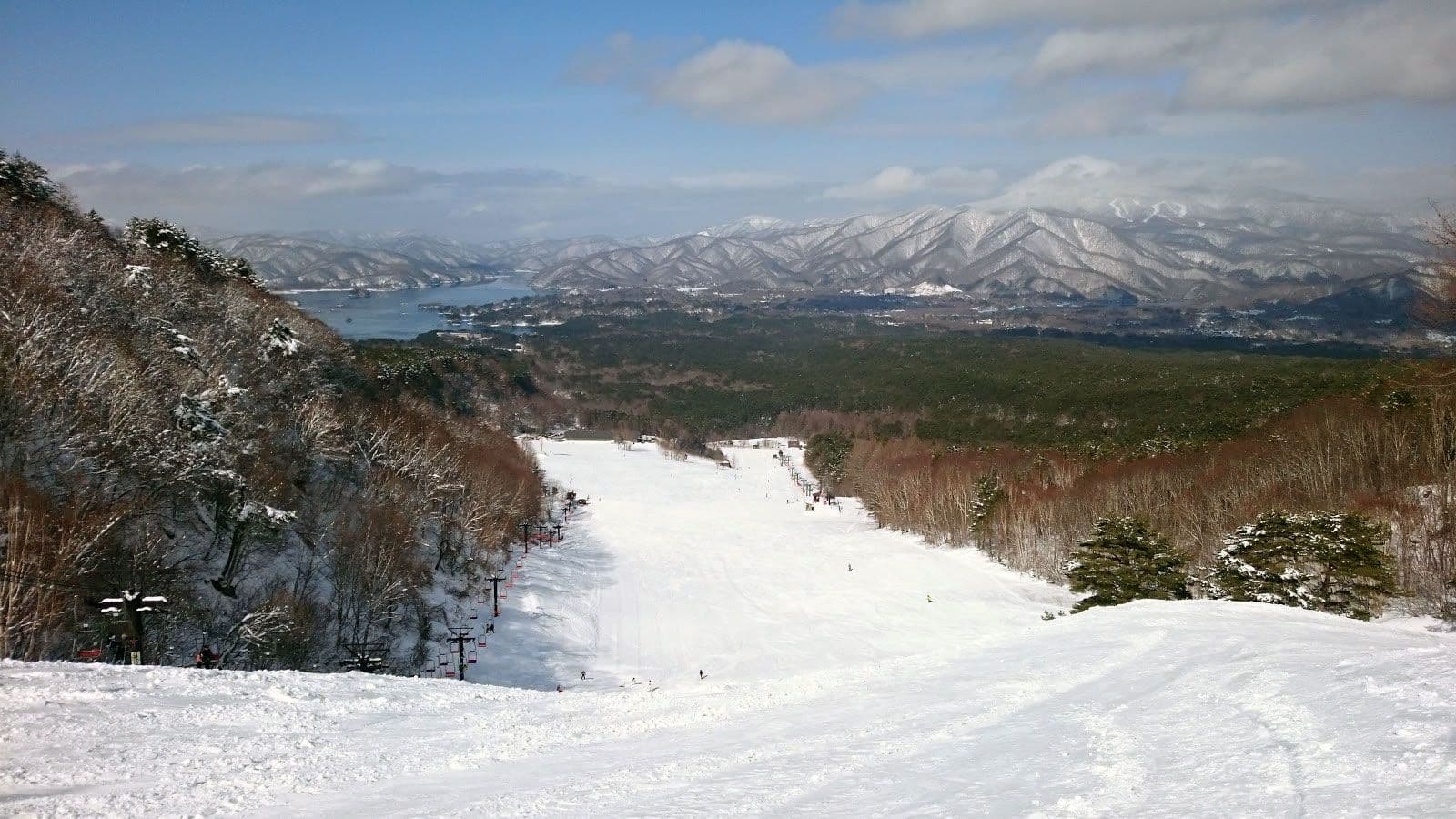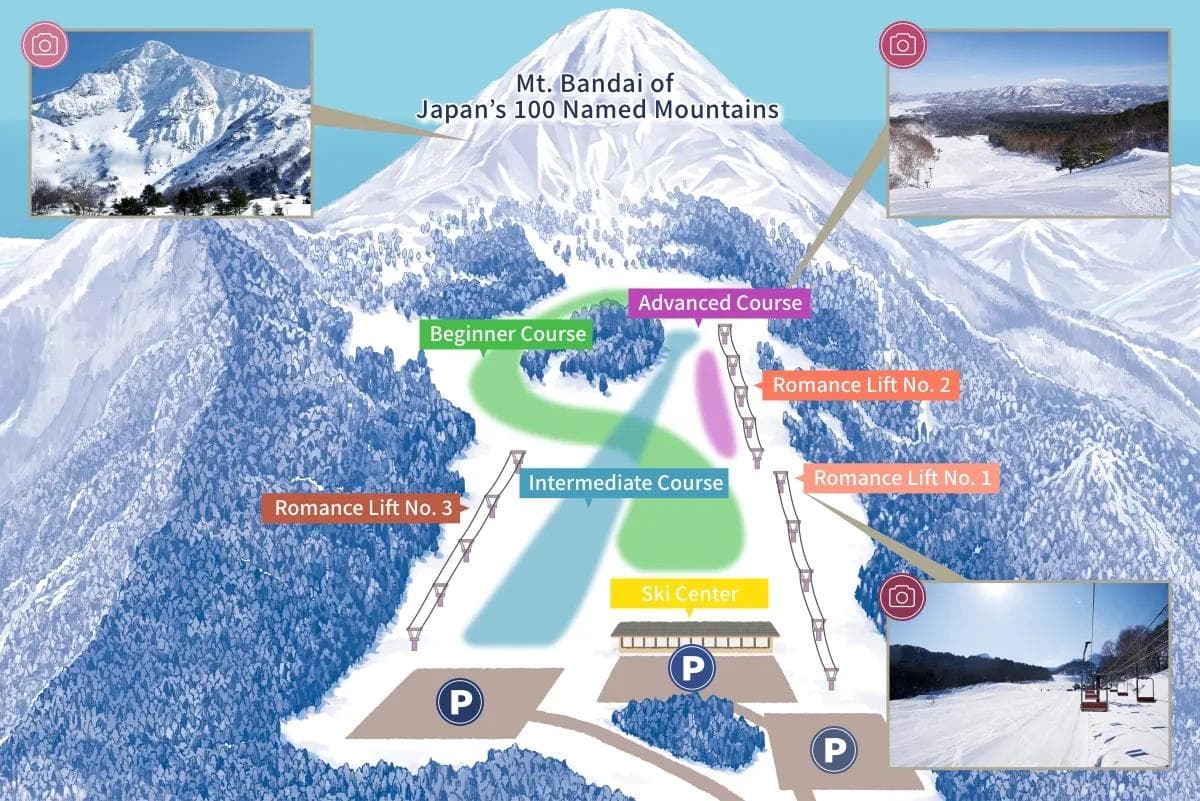Urabandai
Lake views, mellow lines, easy stoke

裏磐梯
Lake views and long cruisers
Urabandai sits on the north side of Mt Bandai, where plateaus and lakes funnel cold air and keep surfaces crisp. On clear mornings you can see the white plate of Lake Hibara from the upper station, then drop into wide rollers that invite clean arcs and a grin you can’t shake. This is a resort built around feel — honest pitches, consistent grooming, and enough vertical for legs to find a rhythm without turning the day into survival mode.
Midweek is blissfully quiet. You’ll hear the clack of bar down more than liftie shouts, and it’s easy to string together hot runs from first chair to lunch without stopping long. Weekends bring local families and school groups, but people spread quickly across the three chairs and the main blue lane absorbs traffic well. The small scale works in your favor — parking is straightforward, the base lodge is steps from the snow, and nothing feels chaotic.
Urabandai is friendly on the wallet. The lift ticket is kind, cafeteria prices are sane, and the whole operation has a locals-first sensibility. English isn’t widespread, yet the routine is simple and signage is straightforward, so if you’ve done a Japan trip or two you’ll slide right in. The kids’ room and indoor practice area help on stormy days when tiny humans need a warm reset.
For storm chasers, this is the carve-and-chill day on a Bandai road trip. Hit Urabandai between deeper missions to tree-heavy neighbors, enjoy corduroy mornings that turn to butter as temperatures ease, and sneak a few soft turns on the marked ungroomed strips after a reset. It’s also the trailhead for winter walks to the Yellow Falls ice formation — a uniquely Urabandai bonus that adds a little wonder to the trip.
Resort Stats
- Vertical300m (1200m → 900m)
- Snowfall~7m
- Terrain 40% 30% 30%
- Tree Riding
- Lift Pass$26
- Lifts3 pair
- Crowds
- Out of Boundsnot allowed
- Night Skiing
- Family Friendly
- Trails3
- Skiable Area~30ha
- VibeLake views, carve culture, local and mellow
Trail Map

Powder & Terrain
When it resets, start up top on the No. 3 pair for crisp fall-line groomers, then drift to the marked ungroomed strips and piste edges where boot-top pockets hide along the rollers. Wind buff often smooths the upper pitches after a blustery night, and dust on crust softens by late morning. The pattern is simple — carve early on hero snow, hunt soft margins late morning, then return to chalky lanes as the shadows lengthen. Boundaries are firm, there’s no gate network, and patrol keeps ropes tight, so keep it in-bounds and let the terrain’s natural flow do the work.
Who's it for?
Urabandai is a sweet spot for carvers, confident intermediates, and families who value calm over chaos. If your perfect day is a string of clean arcs with the odd slash off a berm, this hill fits. Powder hounds will still find fun on reset mornings, but tree fanatics and gate-system seekers will be happier pairing Urabandai with a deeper day at Nekoma or Grandeco. Park rats should expect side hits rather than a full feature park.
Accommodation
Closest to the slopes you’ll find lakeside hotels, pensions, and minshuku that lean into rural Tohoku warmth — cedar interiors, steaming ofuro, early breakfasts, and hosts who know the morning rhythm. It’s a cozy base for first chair and a quiet night.
If you want a bit more polish, larger resort hotels around the Goshikinuma area deliver onsen soaking, buffet dinners, and easy parking. They’re convenient for families and mixed-ability groups thanks to big rooms and kid-friendly facilities. You’ll trade a touch of local quirk for efficiency — a fair swap if you’re moving every couple of days across the Bandai area.
Storm chasers should also consider business hotels in Inawashiro or Koriyama. Late check-in, coin laundry, and convenience stores make quick turnarounds painless, and you can pivot each morning toward Urabandai, Nekoma, Minowa, or Inawashiro depending on wind and snowline. It’s not glamorous, but it’s ruthlessly practical when the forecast is shifting.
Food & Après
On-mountain, the cafeteria sticks to winter classics done right: curry rice, tonkatsu, big bowls of ramen, and trays of karaage that hit the spot on cold days. Coffee is basic but hot, and there’s usually something sweet at the register for a mid-morning breather.
Down the road, small diners handle the post-ride appetite with Aizu staples — sauce katsu-don, hand-cut soba, and warming nabe when the mercury plunges. Après is mellow and daylight-centric. Expect lot beers as the alpenglow fades, then a short drive to a bath and a hearty meal. If you need something livelier, plan a one-off evening in Koriyama before rolling back toward the lakes.
Getting There
From Tokyo, the cleanest drive heads up the Tohoku Expressway to Koriyama, then west on the Ban’etsu Expressway to the Inawashiro Bandai Kogen IC and into the Urabandai plateau. In clear conditions you’re looking at roughly 3–3.5 hours from the northern suburbs depending on traffic. Once off the highway, the final approach can glaze quickly — winter tires are non-negotiable and carrying chains is smart when a system is lining up.
Trains are straightforward: Tohoku Shinkansen to Koriyama, transfer to the Ban’etsu West Line to Inawashiro, then local bus into the Urabandai highlands. Buses thin out midweek, so build your day around the timetable rather than the other way around. For flights, Fukushima Airport is the closest domestic gateway; many visitors still route via Sendai or Haneda and come by rail or rental car.
Japow Travel Tips
- Lift hours: Typically 08:30–16:00 in winter. No night skiing — front-load your day for the best snow.
- Lifts & layout: Three pair chairs cover the hill efficiently. The No. 3 chair is your go-to for the longest fall line and best morning corduroy.
- Out of bounds / gates: No gate network and ropes are firm. Patrol may pull your pass if you duck — keep it in-bounds.
- Yellow Falls: The winter icefall trailhead leaves from near the upper area. It’s a snowshoe trek, not a ski zone — respect closures and signage.
- Weather behavior: Interior exposure means colder mornings and decent chalk hold between systems. Expect wind buff smoothing exposed pitches after gusty nights.
- Crowd pattern: Light midweek; weekends bring families, but the main blue absorbs traffic and the upper chair turns well.
- Payments & language: Limited English. The ticket window usually handles cards; small eateries and pensions may prefer cash.
- Became popular in recent years: No — steady local favorite with a small bump in winter trekking interest thanks to Yellow Falls.
- Prices around the resort: Cheap to mid — fair cafeteria prices and good-value pensions.
- Pairing ideas: Combine with Nekoma Mountain for colder north-facing snow, Grandeco for higher elevation and longer season, or Inawashiro for night turns and lake views.
Quiet hill, loud carving
Urabandai won’t flood your feed with rope-drop drama — it rewards riders who love feel over flash. Clean fall line, calm lifts, and lake views make it the perfect reset day on a Fukushima tour. Time it for a midweek visit, lean into the corduroy early, mine the soft margins after a reset, and let the simple rhythm do its thing.